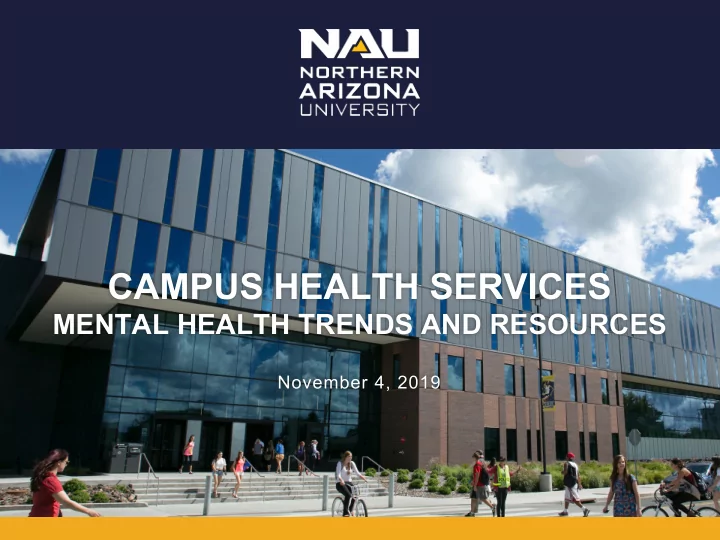

CAMPUS HEALTH SERVICES MENTAL HEALTH TRENDS AND RESOURCES November 4, 2019
Percentage of students past 12 months Treated for anxiety Overwhelming anxiety 10.4% in 2010 46.4% in 2010 24.0% in 2019 66.4% in 2019 131% increase 43% increase Source: 2010, 2019 ACHA NCHA II
Percentage of students past 12 months So depressed it was difficult to function Treated for depression 9.7% in 2010 28.4% in 2010 20.0% in 2019 46.2% in 2019 106% increase 63% increase Source: 2010, 2019 ACHA NCHA II
Percentage of students past 12 months Thoughts of suicide 6.0% in 2010 14.4% in 2019 140% increase Source: 2010, 2019 ACHA NCHA II
NAU MENTAL HEALTH TRENDS Experienced the following within the past 12 months: NAU % National % Felt things were hopeless 61.9 57.5 Felt overwhelmed by all you had to do 85.9 88 Felt very lonely 67.9 67.4 72.5 72.0 Felt very sad 49.4 46.2 Felt so depressed it was difficult to function Felt overwhelming anxiety 77.4 66.4 Seriously considered suicide 17.2 14.4 Attempted suicide 2.4 2.3 American College Health Assessment- National College Health Assessment Spring 2019 (N=529)
NAU M ENTAL H EALTH T RENDS High-Risk Mental Health Trends 15-16 16-17 17-18 18-19 Crisis appointments 297 275 488 590 Students hospitalized for 61 58 77 96 mental health reasons
CHS MENTAL HEALTH SERVICES CHS Counseling Medical Health Services Services Promotion Primary Case Care Management Psychiatry Behavioral Health Care Management
C URRENT S TATE AT C OUNSELING S ERVICES • Successfully hired five of six new positions during summer and fall 2019, including a Latinx Specialist. • Unique students served up 30% over same time last year; total visits up 25%; crisis visits up 83%. • With the continued increase in requests for services, it has become clear that the additional hires are not enough to cover demand (rise in acuity, volume, etc.). • Counseling Services is managing a waitlist for ongoing individual counseling, but continues to offer same-day crisis visits and has immediate group therapy openings. • Continue to carefully manage the schedule and access to services, as well as keep campus constituents apprised of availability.
P SYCHIATRIC C ARE • Housed within Medical Services • Medication management for students and employees • Medications often take 3-6 weeks to start to work • Staffing • Equivalent of 2 full-time Psychiatric NP • 1 unfilled psychiatric position (psychiatrist or psych NP) • Primary care providers can prescribe medications for straightforward patients/students/employees but refer more complicated cases to psychiatric specialty care
B EHAVIORAL H EALTH S ERVICES • Early Intervention Preventing progression of mental health issues • Patients are identified for Behavioral Health (BH) services by Primary Care Providers or Counseling staff • Behavioral Health Providers - coaching on behavioral modifications • Provide same-day brief interventions • Skills-based training Problem solving to address mental health issues • Self-management strategies • Coaching students on managing their health • Chronic disease and medication management • Sleep hygiene
C ARE /C ASE M ANAGEMENT • Conduit between services within CHS • Manages high risk cases • Helps navigate through healthcare system - Identifying resources - Referrals to outside resources - Transportation - Insurance • Treatment adherence - Following provider care plan - Appointment attendance - Medication management
H EALTH L ITERACY Understanding healthcare information and services • Keeping appointments • Accepting available appointment/crisis times • Understanding referrals into the community (specialty care or more frequent sessions) • Limited capacity within CHS Access to care • Availability of resources • Insurance • Transportation Making healthcare decisions • Self-advocacy • Adopting healthy behaviors
H OW CAN F ACULTY HELP ? Connecting students to services - Walking students to CHS - calling ahead is helpful so counselors can review chart - Front desk staff have been informed that any student walked over by a staff/faculty member is to be scheduled for a crisis visit - Students are allowed to change their minds - Students arriving independently need to indicate whether or not they would like a crisis visit - Student will be routed to appropriate care Communicating consistent messaging - CHS has a variety of mental health services - Communicate accurate information - Help students understand limitations of services
B UILDING C APACITY A CROSS C AMPUS • Training Opportunities Identifying Students in Distress – for faculty, staff, or students o Kognito – online gatekeeper training – mental health and suicide prevention o § For students For faculty fall 2019 – HLC fee money § o Campus Connect – for faculty, staff or students § Two hour gatekeeper training Warning signs § § How to support students § How to connect students to resources Faculty feedback? o • Peer Support Program Peers supporting mental health wellness o Training students to help students at risk o Help route students to appropriate resources o
Recommend
More recommend